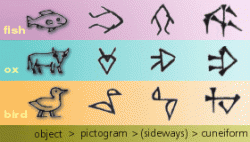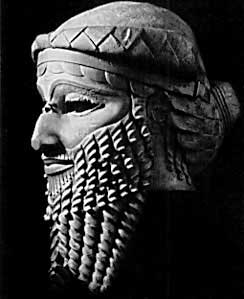Mesopotamia
Writing and Literature
Cuneiform:
Sumerian writing was called Cuneiform, meaning "wedge-shaped" in Latin. It was based on pictograms, or drawings that stand for real objects. The use of these pictograms over time made them abstract and easier to make. The process of writing that the Sumerians used was very different from what we know today. The Sumerians wrote in vertical columns with a sharpened reed as a writing implement. Two developments of this style helped to make cuneiform simpler. They were the conversion to writing horizantally and the use of a new type of reed pen that was pushed into a clay tablet, creating "wedge-shaped" marks.
Sumerian writing was called Cuneiform, meaning "wedge-shaped" in Latin. It was based on pictograms, or drawings that stand for real objects. The use of these pictograms over time made them abstract and easier to make. The process of writing that the Sumerians used was very different from what we know today. The Sumerians wrote in vertical columns with a sharpened reed as a writing implement. Two developments of this style helped to make cuneiform simpler. They were the conversion to writing horizantally and the use of a new type of reed pen that was pushed into a clay tablet, creating "wedge-shaped" marks.

Pictograms
These clay tablets could be baked to make the writing permanent, or they could be recycled for other uses. Cuneiform was used in Mesopotamia for around 3,000 years, until other styles of writing took over. Today the letters of the cuneiform alphabet have been translated and records of poems, stories, and essays have been found. Cuneiform was a major accomplishment of the people of ancient Mesopotamia, and was the first style of writing on the earth.

Literature:
The Epic of Gilgamesh was a story written in cuneiform about a the adventures of the ancient king of Uruk (2750-2500 B.C.E.), who was two parts god and one part man. It was written on twelve clay tablets by a Sumerian, Shin-eqi-unninni, the oldest author known by name, and was very similar to the Odyssey. This epic contains the story of the Flood, a major part of the Christian Bible. The Epic of Gilgamesh is a connection of the Sumerian race to present-day humans.
The Epic of Gilgamesh was a story written in cuneiform about a the adventures of the ancient king of Uruk (2750-2500 B.C.E.), who was two parts god and one part man. It was written on twelve clay tablets by a Sumerian, Shin-eqi-unninni, the oldest author known by name, and was very similar to the Odyssey. This epic contains the story of the Flood, a major part of the Christian Bible. The Epic of Gilgamesh is a connection of the Sumerian race to present-day humans.
